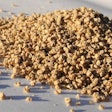
Profitability in poultry production can only be optimised when everything goes right, and that includes keeping the birds healthy. Many diseases start, directly or indirectly, in the gastrointestinal tract. In the recent past, mistakes could be corrected by including antimicrobials in the feed but this option has been eliminated in those regions of the world where antibiotic growth promoters have been banned or heavily restricted.
Nevertheless, establish and maintain a healthy microbial balance by feeding the right nutrients and keeping pathogens under control, and success can be achieved. Four internationally recognised experts presented their knowledge on this topic at a recent seminar organised by Alltech.
Establishing intestinal balance
Professor Moran of Auburn University in the USA set the scene for optimising health by describing how the intestinal balance is established. The gastrointestinal system receives an infinite array of feedstuffs for nutrient retrieval, while encountering a variety of threats to function. Tiny intestinal villi are especially acute to optimising digestion with feed change, and rapidly responding to threat. Villi accommodation involves adjustments in both the rate of cell replacement and modification of its exposed surface. The number of villi per unit area changes exposure to the lumen and modulating their length adds another means for optimisation. Surface at the top half of villi is represented by enterocytes that perform digestion-absorption within the confines of an adhering mucin from adjacent goblet cells. The vascular system is crucial and arterioles supplying the villus and crypt diverge from the main branch to support different activities. An arteriole proceeds to the apex of each villus with branches of venules, subsequently flowing adjacent to the outer surfaces down to the base. Vascular exchange at the villus top provides oxygen for enterocyte-goblet functioning, while removing absorbed nutrients to maintain a gradient from the lumen. Continuation of blood flow past immature cells located on the lower villus enables remaining oxygen and recently absorbed nutrients to support progressive development and replacement of an ageing mature surface.
Stem cells located in the villus crypt not only act as origin for the entire covering but provide for either an expanding or contracting villi number. Arterioles diverted to villi crypts convey post-hepatic nutrient levels and hormonal information as basis for cell multiplication commensurate with the body's state as a whole. New cells entering at the base of the villus are not committed to function until after encountering venule blood that converges from crypt and upper villus. Vascular nutrients at this time appear to provide a basis for establishing digestive enzymes in phase with need while immunoglobulins can be recovered for eventual insertion and protection at the surface. Multiplication also diminishes and a most favourable enterocyte-goblet cell relationship becomes established for maturation. A rolling' three-day turnover permits continual and rapid adaptation at any one location along the intestine.
Maintaining an intestinal system acute to change is essential for optimising animal performance and health.
Understanding gastrointestinal tract microflora
Resurgence of interest in the behaviour of commensal bacteria in the intestine has led to a remarkable transformation in our view of how bacteria participate in intestinal health, explained Professor Lee of the Poultry Diagnostic and Research Center at the University of Georgia, USA.
Consequences of the ban on antibiotic growth promoters are increases in the prevalence of necrotic enteritis and dysbacteriosis in poultry. The former condition is caused by Clostridium perfringens, which is an almost ubiquitous spore-forming anaerobic bacterium that young chicks are exposed to at a very early age. Diet composition is a contributing factor and conditions that result in damage to the intestinal mucosa or disturbance to the normal intestinal microbiota appear to predispose birds to the disease.
There are over 1012 bacteria within the intestine of an animal, and the composition of this intestinal microbial community plays an important role in animal health and performance through its effect on gut morphology, nutrition, pathogenesis of intestinal disease and immune response. One of the most important functions of the intestinal microbiota is to suppress pathogenic populations of bacteria. It has been shown that germ-free birds that were reconstituted with either lactobacilli or enterococci were more resistant to colonisation with Cl. perfringens. Some members of the intestinal bacterial community also exhibit anti-inflammatory effects on the mucosa and may stimulate mucosal immunity.
Due to the limits of culture techniques, molecular methods are increasingly being used to analyse bacterial communities. Several studies addressing the composition of chickens' intestinal microbiota have shown that lactobacilli and enterococci are abundant, and that diversity and the prevalence of clostridia varied with different diets and the use of probiotics and antibiotics. Studies have identified novel intestinal clostridia and it is thought that they may contribute to the health and performance of animals. It has been demonstrated that some induce or enhance intestinal development and are likely to be non-pathogenic. While behaving as intestinal symbionts, these clostridial communities can also potentially act as a competitive suppressive ecosystem reducing the virulence of Cl. perfringens in the small intestine. Understanding the development of intestinal bacterial communities is necessary to reduce the level of pathogen carriage by poultry, for antibiotic-free treatment of intestinal disease and to improve weight gain and feed conversion.
Feed the birds not the bad' microbes
A commercial nutritionist with strong links to Clemson University in the USA, Professor Williams explained how nutrients in the feed need to be directed at the bird and away from microbes, and how this can be achieved by using feed enzymes.
The major components of cereal grains are polysaccharides, which are macromolecular polymers of monosaccharides linked by glycosidic bonds. To access the energy provided by cereal grain polysaccharides, a process is initiated by a group of enzymes referred to as hydrolases. However, there are polysaccharide compounds in feedstuffs generally known as non-starch polysaccharides (NSPs), which cannot be hydrolysed by the endogenous enzymes of the gastrointestinal tract. In this case, the energy encompassed in such macromolecular compounds is not available to the host animal. The presence or absence of these compounds (NSPs and oligosaccharides) may influence either positively or negatively the microflora of the gastrointestinal tract. Such influences may favour the development of some pathogens and contribute to the severity of certain enteric disease conditions. In addition, these NSP compounds typically cannot be hydrolysed and thus do not constitute a dietary energy source.
Since the carbohydrate content of typical feedstuffs is so diverse in composition and chemical complexity, there is a clear need for effective exogenous enzymes. Thus, to influence the microflora of the intestinal tract in a beneficial manner and to obtain maximum energy contribution from feed ingredients, the selection and use of a complex of exogenous enzymes seems appropriate and necessary.
Coccidiosis control in Europe
President of the World Veterinary Poultry Association, Professor Hafez of the Free University in Berlin, Germany, was invited to speak about coccidiosis.
Coccidiosis is the major parasitic disease of poultry with substantial economic losses due to malabsorption, impaired feed conversion, reduced weight gain and higher mortality. In addition, anticoccidial drugs and/or vaccines for treatment and prevention contribute to the production cost.
Coccidia are protozoa with the ability to multiply rapidly inside cells lining the intestine or caeca. The seven species of coccidia that infect poultry belong to the genus, Eimeria. It is practically impossible to totally decontaminate poultry houses that have been previously contaminated with coccidia.
Several eimeria species cause clinical symptoms in infected and unprotected birds. However, sub-clinical infections also frequently occur. They are often under-estimated but they can adversely impact feed conversion and weight gain.
Currently, the prevention and control of coccidiosis is based on good hygiene, chemotherapy (anticoccidials) and immunisation. At present, several types of anticoccidial drugs are available, including synthetic compounds (chemicals), quinalone and ionophore antibiotics. The efficiency of anticoccidial agents can be reduced over time by resistance to the drugs.
Several management programmes are designed to prevent the development of resistance, which result in better gut health and feed utilisation by birds. In addition, several different live vaccines have been commercially developed. These are mostly composed of either virulent or attenuated parasite strains. The use of vaccines can replace drug-resistant field strains of eimeria with drug-sensitive vaccine strains. Long-term sustainability of coccidiosis control in poultry might therefore be facilitated by the adoption of rotation programmes, involving the alternate use of a vaccine and a drug in successive flocks.
Recently, trials have been carried out to determine the efficacy of alternative products, such as herbal extracts, to control coccidiosis under experimental conditions. The results have been inconsistent.
Generally, an anticoccidial drug or vaccination alone is of little value, unless it is accompanied by improvements in all aspects of management. More attention should be given to improving sanitation and hygiene at farm level, including factors that affect litter quality, correct installation and management of watering systems, sufficient feeding space, maintaining the appropriate stocking density and adequate ventilation.






